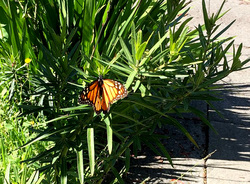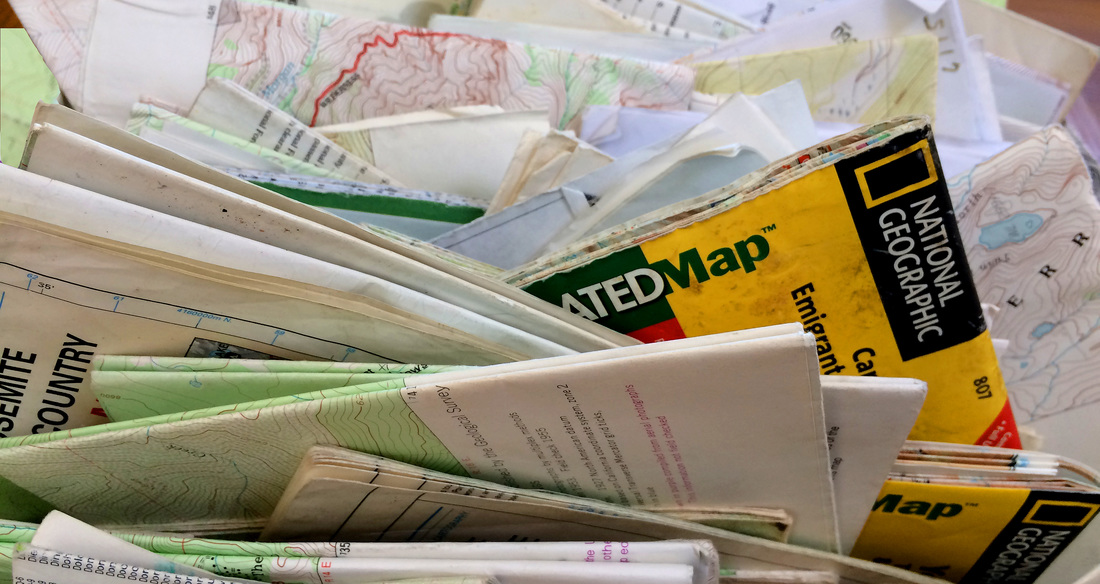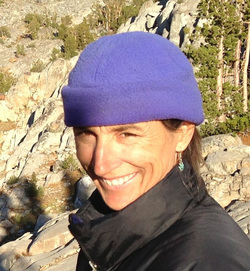A map is the earth in the palm of your hand.
Might be I’m at a mountain pass, the topographical world spread out below, the palpable Sierra sun drying the shirt sticking to my back, the col I just climbed no more than lines on the map here in my hands. The map cries out “I’m here!", a dot amidst the serrated ridge which has been flattened to concentric circles between my thumbs. But ultimately, the map reveals nothing, indifferent to my sweat-soaked climb, to the lack of oxygen, and the desperate flight of a startled junco from under my feet, and equally silent about whoever might be on the top of that distant stark peak, exultant. Or maybe even stranded.
But when I’m far from their tangible underpinnings, maps are so achingly compelling. There can be nothing more beautiful than, at the table in my kitchen, a map’s contours describing a distant landscape right there in front of me. Under the muted warmth of a 60-watt light bulb, I disappear into the dream of mountains, smelling again the gunpowder of granite in the hot sun. Then, with sudden surprise, startle into focus to see only the flat, lifeless expanse of inked and creased paper in front of me.
They may be beautiful, but – seriously -- when has a human construct ever been so uncreative? That peak is there. This col is here. No room for argument. No standing in front of this at the Guggenheim and contemplating the subtle meaning in the upstroke of the brush. No interpretation of the profound use of color.
A map is the earth in the palm of your hand, wrote Beryl Markam in West with the Night. I love that. But I would add that a map is an infinity of futures, an irresistible beckoning to your stolid feet. My hundreds of maps are stained with tea and ramen, victims of hours of scrutiny during a one-pot dinner with heather and penstamon guests. And late into the evening, the saluting fingers of a setting sun lighting the printed letters with crimsons and oranges. And even later into the headlamped recesses of the night.
And at the same time, a map is record of a rather more finite past. Here is where that avalanche tumbled down from Makalu La and almost buried camp. Here is the high Sierra meadow where my boyfriend stood, awed and transported by the cacophony of flowers, the guttural stanzas of an enthusiastic stream… then put his arm around me and proposed.
Might be I’m at a mountain pass, the topographical world spread out below, the palpable Sierra sun drying the shirt sticking to my back, the col I just climbed no more than lines on the map here in my hands. The map cries out “I’m here!", a dot amidst the serrated ridge which has been flattened to concentric circles between my thumbs. But ultimately, the map reveals nothing, indifferent to my sweat-soaked climb, to the lack of oxygen, and the desperate flight of a startled junco from under my feet, and equally silent about whoever might be on the top of that distant stark peak, exultant. Or maybe even stranded.
But when I’m far from their tangible underpinnings, maps are so achingly compelling. There can be nothing more beautiful than, at the table in my kitchen, a map’s contours describing a distant landscape right there in front of me. Under the muted warmth of a 60-watt light bulb, I disappear into the dream of mountains, smelling again the gunpowder of granite in the hot sun. Then, with sudden surprise, startle into focus to see only the flat, lifeless expanse of inked and creased paper in front of me.
They may be beautiful, but – seriously -- when has a human construct ever been so uncreative? That peak is there. This col is here. No room for argument. No standing in front of this at the Guggenheim and contemplating the subtle meaning in the upstroke of the brush. No interpretation of the profound use of color.
A map is the earth in the palm of your hand, wrote Beryl Markam in West with the Night. I love that. But I would add that a map is an infinity of futures, an irresistible beckoning to your stolid feet. My hundreds of maps are stained with tea and ramen, victims of hours of scrutiny during a one-pot dinner with heather and penstamon guests. And late into the evening, the saluting fingers of a setting sun lighting the printed letters with crimsons and oranges. And even later into the headlamped recesses of the night.
And at the same time, a map is record of a rather more finite past. Here is where that avalanche tumbled down from Makalu La and almost buried camp. Here is the high Sierra meadow where my boyfriend stood, awed and transported by the cacophony of flowers, the guttural stanzas of an enthusiastic stream… then put his arm around me and proposed.

Weeding in my Berkeley garden today, I looked up to see a monarch butterfly teetering giddily through the sky towards me. What had it seen from its lofty, wind-born heights in this streetscape of concrete and harsh angles that stretches from the Bay to the hills, what enticed it downward?
Inside the carapace of her royal head is a map that renders insignificant all the maps in my attic, a map that stretches from Washington to here. Her maps are imprinted with the memory of gliding on winds through North Cascades passes, drinking dew from Oregon coastal dunes, her poetry written with allegories of nectar from the volcanic slopes of Shasta or the granite domes of Yosemite. Her map takes in the broad sweep of the land below her wings, but also puts a pin in the map at that one irresistible, nodding flower. Hers is a lacework map of infinitesimally small, connected flowers, points too small for us to fathom. Humans scrawl a monarch migration with the equivalent of a fat, orange crayon.
My eyes followed the monarch as she circled down and down, gently, shyly almost, a brilliant splash of orange landing finally in the crowded cluster of green in the berm between the sidewalk and the road. She has landed on a milkweed.
I gaped with wonder, naïve in the presence of such calculated precision. Monarchs need milkweed so specifically she is called the milkweed butterfly. How do the monarchs find the milkweed I’ve planted there? But they do, over and over again. As far as I know, this is the one milkweed plant in all of southside Berkeley. In reality, I don’t know. But she does. She may know every stem from where she took flight this morning in Mendocino to this scraggly specimen amidst the parked cars, the curb, the concrete and the crowding montbretia on the roadside verge.
As they drowse at night, perhaps butterflies pore over their internal map and plan their route for the following day. Perhaps their hearts do somersaults and their stomachs tighten in fear, worrying if they have strength enough to get over the Klamath Mountains. Perhaps they love soaring above the waves that roll down the beaches and crash against the cliffs of the California coast and can’t sleep the night before, for their eager anticipation. And perhaps, just perhaps, they come to this patch of milkweed in the midst of an impenetrable urban landscape over and over again, because it’s a one-dot-oasis, the famous Stop Here and Get Gas layover. Perhaps it is one of many, or one of few, here amid the concrete, which gives them a place to rest before they move on to the real attraction they’ve been dreaming about further along the wind’s ribbon of highway.

